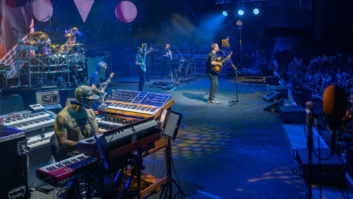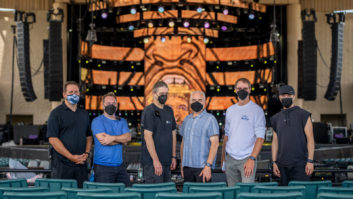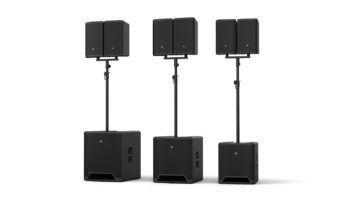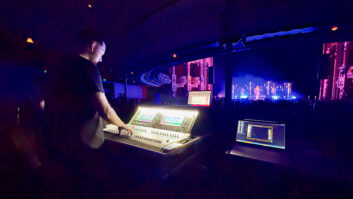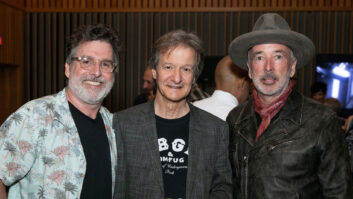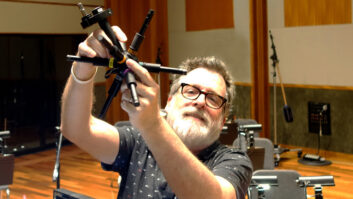Following a string of dates at outdoor amphitheaters, the Dave Matthews Band (DMB) began the stadium leg of their current tour with two nights at Pacific Bell Park, the new home of the San Francisco Giants baseball team. With support acts Angelique Kidjo and Macy Gray on the bill, both of the performances were sold out by showtime.
Completed in time for the 2000 baseball season, PacBell Park had not previously been used as a music venue (except for a private party last year where Barenaked Ladies performed). The Dave Matthews Band was to be the first major rock act to perform in concert at the ballpark, and the local newspaper made much of the preventive measures taken to protect the playing field. (Curiously, the articles failed to note that a season’s worth of XFL football matches had been held on the same field.) Due to concern for the playing surface, the outfield was covered with plastic panels that allowed the grass to breathe, and the infield was fenced off. The lighting control area covered second base, while the FOH mix position was placed opposite the right speaker stack in shallow right field.
UltraSound, a division of Pro Media (El Sobrante, Calif.), has been providing sound systems and crew for the DMB for the past seven years. At PacBell Park, UltraSound set up two main P.A. towers flanking the stage, each containing six Meyer Sound MSL-10s, 14 MSL-3s and 16 650 subwoofers. Two MSL-2s were used for front fill, and four delay towers contained two MSL-10s and two MSL-2s each, with the speakers rigged at the height of the second level of seats in the stands. An analog line from the FOH position to the closest delay tower looped from there to the other towers, while the FOH send to the main P.A. system was a 24-bit digital signal. All of the Meyer speakers were driven with Crest amplifiers.
FOH SLIMS DOWN
At FOH mix position, DMB engineer Jeff Thomas mixed on a modified Gamble EX66. UltraSound also provided a Midas Heritage 3000 for Macy Gray and a Crest VX40 for opening act Angelique Kidjo. Though much of the FOH compound was taken up with DMB’s recording gear (see sidebar), it contained a surprisingly small number of “drive racks.” Instead, UltraSound has been using the BSS Soundweb. As system engineer Derek Featherstone explains, “We had a 22-space drive rack with tons of EQ in it, and I thought, ‘If we can take all these EQs and assign them to zones, and run the system with up to 12 zones and convert it to a one-rackspace Soundweb with horsepower, we’d have something.’”
In consultation with Featherstone and DMB FOH engineer Jeff Thomas, UltraSound principal Don Pearson has developed a Soundweb program that allows the entire sound system to be controlled from a laptop, allowing for zone-by-zone EQ adjustments. In fact, says Featherstone, the entire sound system can be monitored and controlled from two laptops; the second one runs SIA’s Smaart Pro 4.5 software and is used for real-time analysis. Any of four microphones positioned around the venue can be switched to the Smaart system inputs, allowing the engineers to look at the FFT response in that section of the venue.
The Smaart system also allows the crew to compensate for changes in temperature, humidity and wind speed. And, says Featherstone, “You can sit with a computer connected to a T1 line in every building we go to, and we can see, through satellites, what the weather is doing. We can prepare ourselves for both the physical challenge of being rained out and the need for system tuning changes brought on by weather and temperature movement.”
Asked about his choice of components in the main speaker system, Featherstone praises the horizontal array characteristics of the Meyer MSL-10s. “Over time, we determined that MSL-3s, tight-packed together, create a lot of 12-inch speaker buildup,” he explains, noting that the result shows up as extra energy in the 240Hz range. “By the nature of how the MSL-10s are laid out, and these points we flew off, we achieved a good horizontal and vertical [coverage pattern] and broke up some of the 12-inch coupling.” The subwoofer stacks, made up of Meyer 650s, tower 16 cabinets high. “We have safety cables halfway up that are tensioned out to the side to remove oscillations in the stack caused by wind,” says Featherstone. “The result is a safe 40-inch-tall stack that can throw sub power up to 350 feet.”
Coincidentally, the ballpark’s permanently installed JBL speakers are part of a design put in place by UltraSound’s senior partner, Pro Media. Though Featherstone made a line available for patching a supplementary FOH mix into areas of the park as needed, it turned out to be unnecessary.
Although signal processing at FOH is comprehensive, Featherstone notes that “we’ve gotten to the point at FOH where there are no gates.” As Thomas explains, “Carter [Beauford] is an extremely dynamic drummer, and we don’t want to miss a single note.” For dynamic control, Thomas uses one side of a Tube-Tech LCA 2B for the kick drum, runs snare and overheads through an Empirical Labs Distressor and assigns the toms to another Distressor. “Since the entire system is mono, I can sum instruments together and use one compressor on multiple inputs,” he says.
Thomas lays out his mixing surface in a traditional manner and makes extensive use of subgroups — only kick drum bypasses the subgroup section. Subgroup 1 is for vocals, 2 contains overheads, snare and hi-hat, 3 has the toms, 4 is for bass, 5 for guitar, 6 for violin and 7 for sax. Group 8 is reserved for special guests — for the Friday show, the DMB was joined by Carlos Santana for three songs, including “All Along the Watchtower,” and on Saturday, Trey Anastasio from Phish showed up to jam.
Though Thomas handles dynamic control and EQ at FOH, several of the musicians provide their own effects from the stage. For example, both violin and bass guitar have a “wet” and a “dry” channel. “Each member of the band has an Eventide Ultra-Harmonizer of some sort, and the sax player has an Eventide DSP4500, as well as a TC Electronic M5000,” explains Thomas, who adds occasional short reverb to Matthews’ guitar and uses a TC M5000 for drum and vocal reverb. Additional effects units at FOH include an Eventide Orville, a TC 2290 and a Lexicon PCM 42.
MIXING MONITORS ON THE PM-1D
At the monitor position, DMB monitor engineer Ian Kuhn is using a Yamaha PM-1D, the first to be purchased by UltraSound. “This is its first journey,” says Featherstone. “It’s been holding up pretty well. It’s very efficient, and you can do a lot of things with it.”
Kuhn creates in-ear monitor (IEMs) mixes for the majority of the band on the PM-1D, while DMB crew chief Lonnie Quinn mixes for the violinist’s in-ear monitors on a Gamble EX56. The Gamble is also configured to act as a backup console in case the Yamaha goes down. All the in-ear monitors are Shure wireless systems.
Though new to the PM-1D, Kuhn is more than comfortable with it. “We used to have TC Finalizers patched into the in-ear monitors, but now the Yamaha console does all that for us,” he notes. “It doesn’t have the multiband compression, but we’re not missing it. We’re even using the built-in effects. Also on this board, I can set up a guest mix and then copy it to any other mix by hitting ‘copy mix.’” In addition to the regular lineup, the DMB added three backup singers for this particular leg of the tour. They were provided with Meyer USM-1 floor monitors that were powered by Crest 7000 amplifiers.
Kuhn and the rest of the stage crew use a computer network to keep up with the ever-changing set list, a trademark of DMB shows. “We have a whole database accessible here at the monitor position, which shows cues for each song, as we’ve entered them in previous shows,” Kuhn explains. “The set list gets entered during a show day, and it appears on everybody’s machines all around the venue. At any time, we can just click on any song and get our cues. This same database remembers every set list we’ve ever done, and before the show, I’ll print up a group of set lists for every show we’ve done in this area. It can then be modified so the fans get a different show than last time.”
While the concert was going on in their hometown, the San Francisco Giants were playing in Atlanta, where rain delays caused the game to last longer than the concert. At about the time that Trey Anastasio left the stage, Barry Bonds hit his third home run of the day.
Producer/engineer David Ogilvy lives in Northern California and has witnessed over 3,000 live performances.
THE DMB CREW
Band engineer: Jeff Thomas
Monitor engineer: Ian Kuhn
System engineer: Derek Featherstone
FOH technician: Tim “Quake” Mark
Crew chief: Lonnie Quinn
Technician, stage left: Tom Lyon
Technician, stage right: Jeff Child
Technician, delay towers: Scott Harvey
Technician: James Corbin
Live recording/archiving technician: Ryan Nichols
MULTITRACK RECORDING AND ARCHIVING ON THE ROAD
Designed by Dave Matthews Band FOH mixer Jeff Thomas and UltraSound’s Derek Featherstone and Gustav Hobel, the DMB’s road-ready multitrack recording rig can roll right into the studio and plug in. As Featherstone points out, “You don’t want to build it for six months of touring and then park it for six months; you want to get a better return for your money.”
For recording, passive splits from the mic pre’s in the FOH console are routed to a bank of API 212L mic pre’s in the recording rack. Their outputs are then split into both Tascam DA-78s and MX-2424s with removable hard drives, ensuring that the performance will be captured on at least one of the two media formats. A left/right mix is run through an Apogee A/D converter and into two CD-R machines and a DAT recorder.
In order to monitor playback and check on a previous night’s performance, the line-level outputs from the multitracks are run into a device built by Jeff Peters, which drops the level back down to mic level, allowing the tape outputs to run back into the inputs of the Gamble FOH board. “That allows us to not change the gain settings on the board, and since the signal that went to tape is not compressed, gated or processed, all the EQ on this board is relative to the original inputs,” explains Featherstone. “So basically we’re playing back the band again. Jeff [Thomas] can adjust the levels so he doesn’t have to change his mix from the night before, and he can work on a specific instrument or the way the mix is laid out, effects, anything.”
“You can also use it to fire up the monitor systems,” adds Thomas. “You can take the best couple of minutes from a previous show, throw it up on the system right after you EQ the room and touch it up. And when prepping a tour, you can take the multitracks, play them through the board, lay out your compressors, your effects, and walk into the first show with a mix, so to speak.”
Ryan Nichols, who monitors the recording through headphones during the show, explained the comprehensive archiving process. “The computer database designed by Ian Kuhn covers set lists, all our production information — from load-in times to what the facility provides for us — crew calls, any sort of merchandise, accounting or guest list information. The archive section is enormous. There are copious notes that go down for every show — all kinds of data about any overs on tracks, any guest musicians, the multitrack input list, etc. And then it generates serial numbers for each tape, in every type of media that we use. Each one gets an Avery label that is printed out here by the database.
“Every show that gets done on hard disk gets mailed home to Charlottesville [Va.] in one of these Pelican cases,” Nichols continues. “Each case holds two shows. We have an archivist there who empties all the files off the hard drives onto compact disc. Compact disc, megabyte per dollar, seems to be the cheapest medium out there. You can do 8x burning, and each show generates about 10 hours of data transfer.
“Each multitrack show turns into about 110 compact discs. We hold onto the magnetic tape side of the redundant multitrack recording out here on tour, until the archivist gives us the okay — that his data transfer went okay. After the archivist dumps the hard drives, he sends them back to us on tour. We have 20 hard drives, and we use about four a show, so we have about a five-show leeway. And we don’t usually do five shows in a week. But we can’t have too many spares lying around at $500 a hard drive.”
— David Ogilvy
